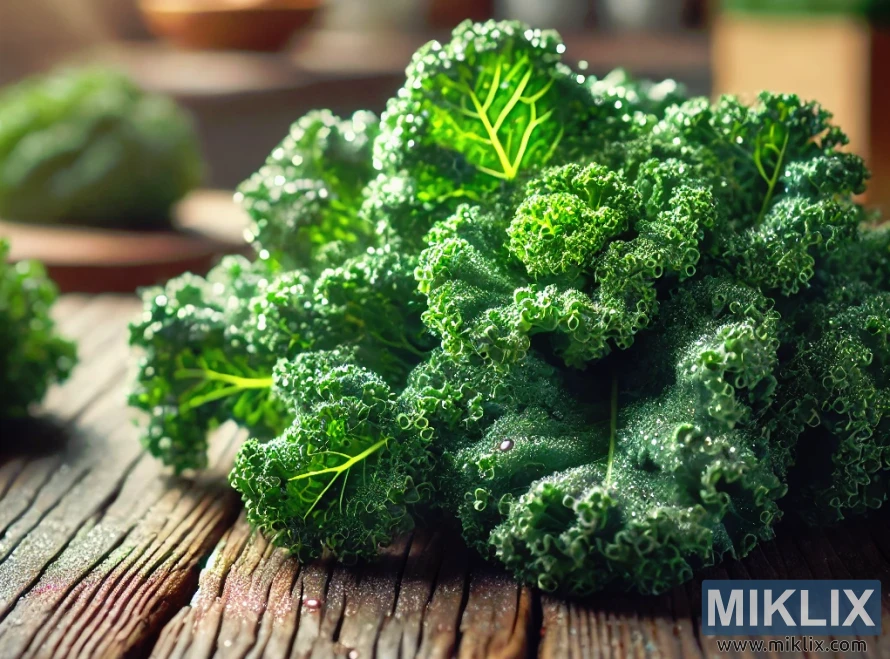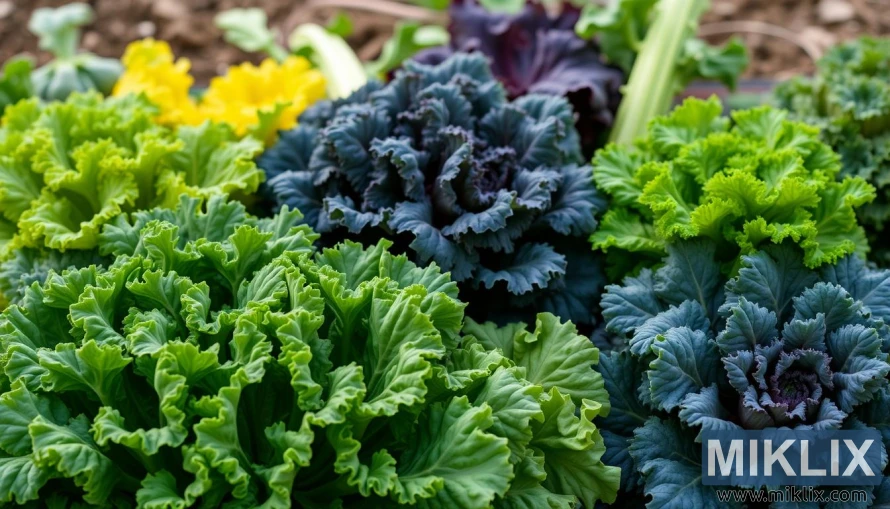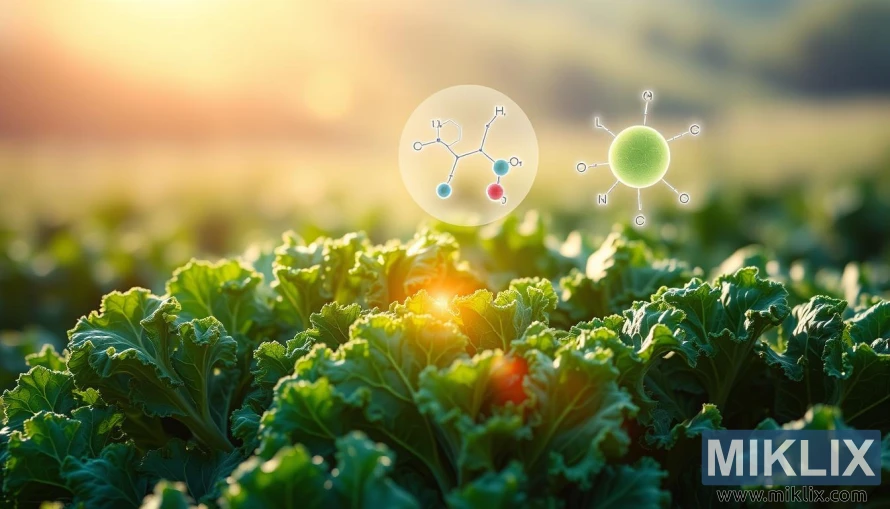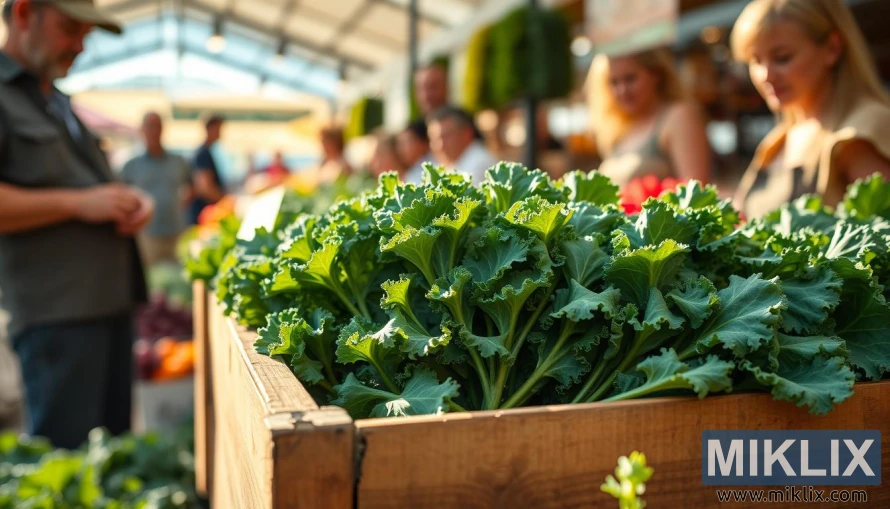Green Gold: Why Kale Deserves a Spot on Your Plate
Published: March 26, 2025 at 6:12:33 PM UTC
Last updated: March 28, 2025 at 3:17:22 PM UTC
Kale is a superfood that shines among leafy greens. It's packed with nutrients in every bite. It belongs to the cruciferous family, like broccoli and cabbage. This makes it a great source of vitamins, minerals, and antioxidants. It's full of vitamin K, vitamin C, and beta-carotene. These help keep your heart, eyes, and digestive system healthy. Kale is also low in calories but high in nutrients, making it perfect for healthy diets.
Kale is loved for its ability to meet daily vitamin needs in small amounts. One cup of fresh kale gives you a significant amount of you daily vitamin and mineral requirements. And it has less than 40 calories per cup. Kale is rich in fiber, calcium, and antioxidants, making it a top choice for healthy eating.
Key Takeaways
- Rich in vitamins and minerals, helping you meet your daily requirements.
- Rich in fiber to support digestion and heart health.
- Low-calorie, high-nutrient profile aids weight management.
- Contains beta-carotene and lutein to protect eye health.
- Part of the cruciferous family linked to reduced chronic disease risks.
What Makes Kale a Nutritional Powerhouse
Kale is packed with nutrients. A single cup has just 35 calories but gives you 5 grams of fiber and 3 grams of protein. It's also rich in vitamins A, C, and K, and minerals like iron and calcium.
- Calories: 35 per cup, making it a light yet nourishing choice.
- Fiber content: 5g per cup aids digestion and heart health.
- Protein content: 3g per cup, a plant-based boost for meals.
- Micronutrients: Vitamins A and C, plus vitamin K for bone health.
Kale beats spinach in vitamin C and has twice as much vitamin K per calorie. It has more fiber than lettuce and as much iron as collard greens. This makes kale a great choice for those looking for nutrient-dense foods.
Kale is low in calories but high in fiber, helping with weight management. It also has antioxidants like quercetin. Its nutritional profile makes it perfect for salads, smoothies, or sautés. Kale's balance of nutrients is why it's called a superfood.
Essential Vitamins Found in Kale
Kale is packed with vitamins, making it a superfood. One cup of raw kale gives you a significant part of your daily vitamin K. This vitamin is key for blood clotting and strong bones.
Vitamin K also helps keep your heart healthy by controlling calcium in blood vessels.
- Vitamin C in kale is three times more than in spinach. It boosts your immunity and skin health.
- Vitamin A in kale comes from beta-carotene. It helps with vision and keeps your immune system strong.
- B vitamins in kale turn food into energy. They help with metabolism and nerve function.
These vitamins help your body fight off sickness, give you energy, and keep you well. It's a great choice for anyone looking to eat healthy.
Impressive Mineral Content of Kale
Kale is not just full of vitamins; it's also rich in minerals that keep your body running. For those who don't eat dairy, kale can help cover you daily calcium needs. This supports strong bones and muscles.
But that's not all. Kale also has potassium, which is good for your heart. And magnesium, which helps with energy and nerve function.
- Calcium in kale promotes bone and heart health.
- Potassium in kale supports healthy blood pressure.
- Magnesium in kale is vital for over 300 bodily reactions.
- Iron in kale aids oxygen transport in blood.
- Copper and manganese in kale add antioxidant power, fighting cell damage.
Iron in kale helps prevent tiredness, and magnesium supports your nerves and muscles. Even a little bit of these minerals can make a big difference. Eating kale with foods high in vitamin C can help your body absorb more iron.
So, whether you sauté it or blend it, kale adds important minerals to your meals. It's a key part of a balanced, nutritious diet.
Antioxidant Properties and Their Impact on Health
Kale is packed with natural defense compounds. These include quercetin and kaempferol, which fight free radicals. This helps protect cells from damage and supports overall health.
Quercetin in kale is good for the heart. Kaempferol has shown to slow cancer cell growth in studies. Kale is rich in these antioxidants, making it a great plant-based choice.
- Quercetin in kale helps combat inflammation and may reduce heart disease risk.
- Kaempferol in kale shows promise in stopping cancer cell growth in lab tests.
- Kale’s vitamin C and beta-carotene boost its antioxidant power.
Studies show kale extracts can reduce free radical damage. Fermentation makes these compounds even more powerful.
Choosing kale supports cell protection and helps prevent chronic diseases. Its rich antioxidant profile makes it a great choice for a healthy diet.
How Kale Supports Heart Health
Kale is a top choice for heart health. It targets high cholesterol and blood pressure, key risk factors. Eating kale regularly can lower LDL cholesterol by binding bile acids in the gut.
A study of 149 people with metabolic syndrome found kale powder lowered LDL cholesterol and blood pressure in 8 weeks. Even a small amount, like 14 grams of powder, shows results. Steaming kale makes it even more effective.
Kale's potassium helps balance sodium, which is good for blood pressure. Its fiber and antioxidants also help. Nutrients like vitamin K, vitamin C, and manganese strengthen the heart.
- Kale contains riboflavin, important for the heart.
- Omega-3 fatty acids in kale fight inflammation, which is good for the heart. This follows dietary guidelines for eating dark-green veggies.
Add kale to salads or smoothies for better heart health. Making kale a regular part of your diet helps prevent heart disease naturally.
Weight Management and Digestive Benefits of Kale
Kale is great for weight loss because it's low in calories. This makes it a top choice among vegetables that are low in calories.
Its high water and fiber content help you feel full. This can stop you from eating too much. The fiber in kale also helps with digestion. It keeps your digestive system healthy and prevents constipation.
Two cups of kale give you 6 grams of fiber. This fiber is split into two types: insoluble and soluble. Insoluble fiber makes your stool bulkier, helping with constipation. Soluble fiber feeds the good bacteria in your gut.
Research shows that kale's sulfoquinovose feeds these beneficial microbes. This improves digestion. Studies on mice found that kale reduced inflammation markers by 66%. This boosts gut health.
- High fiber content promotes regularity
- Low calories make it ideal for weight management
- Sulforaphane compounds support metabolism
Kale has 5 grams of fiber per cup. This helps with digestion and weight goals. Adding it to salads, smoothies, or soups boosts your nutrient intake without adding too many calories. Its fiber also slows down sugar absorption, preventing hunger spikes.
Incorporate this nutrient-rich leafy green into your diet. It supports both your waistline and digestive health.
Kale for Eye Health and Vision Protection
Kale's green leaves are a powerhouse for eye health. They are full of lutein and zeaxanthin, two antioxidants. These act like sunglasses for your eyes, protecting them from blue light and reducing stress.
Kale contains significant amounts of vitamin A. This vitamin is key for seeing in the dark. Eating kale can also lower the risk of age-related macular degeneration, a big cause of blindness in older people.
Lutein and zeaxanthin in kale help protect the macula, the part of the eye that sees clearly. This makes kale a strong ally against AMD.
Make kale salads with olive oil or avocado to get more nutrients. Adding kale to smoothies or sautéed dishes helps your body use lutein and zeaxanthin well.
Start eating kale early to keep your eyes healthy for years. Kale's nutrients fight off damage from UV rays and aging. It's a key food for eye care.
Anti-Cancer Properties in Kale
Kale is known for its cancer prevention benefits. It has glucosinolates, which turn into isothiocyanates when cut or chewed. A key compound, has shown to stop cancer cell growth in lab studies.
Cruciferous veggies like kale may lower cancer risks, studies say. For instance, kale juice slowed neuroblastoma cell growth in just three days, beating other juices.
No food can promise cancer prevention alone, but cruciferous vegetables cancer research supports their role in healthy diets. Experts say kale's benefits are best when part of a balanced diet with other protective foods. Always talk to healthcare providers for tailored cancer prevention plans.
Best Ways to Prepare Kale for Maximum Nutrition
Choosing the right way to prepare kale is key to keeping its nutrients. Raw kale is full of vitamin C and fiber. But cooking can increase antioxidants. Steamed kale is a top choice—it's good for bile acid binding, just like cholesterol drugs.
Try these methods:
- Steaming: Cook for 10 minutes to boost antioxidants. This method keeps vitamin C and increases iron absorption.
- Sautéing: Cook 5 minutes on low heat with olive oil. Adds healthy fats to boost vitamin A absorption.
- Roasting: Toss with olive oil and roast at 325°F (163°C) for crispy chips. Great for a crunchy snack.
- Pressure Cooking: Briefly cook (0 minutes post-pressure) to retain 90% of nutrients. Ideal for quick meals.
Always remove tough stems—they’re bitter. For salads, raw kale benefits from a massage with lemon juice to soften leaves. Pair with fats like avocado or nuts to boost nutrient absorption. Avoid boiling too long, as it reduces vitamin C. For best nutrients, opt for quick methods like sautéing or steaming.
Health tip: Cooking reduces oxalates, aiding calcium absorption. Add garlic to enhance iron uptake. Explore these methods to enjoy cooking kale while keeping its nutrients intact.
Potential Side Effects and Considerations
Kale is full of nutrients, but it can cause kale side effects for some. People with health issues or on medications should be careful. Always talk to a doctor before adding large amounts of kale to your diet.
Kale thyroid issues can happen because of goitrogens. These compounds can affect iodine levels. If you have a thyroid problem, eat cooked kale instead of raw. Most people can safely eat kale in moderation.
Those on blood thinners like warfarin need to be careful. Kale has vitamin K, which helps blood clot. This can affect your medication. Always check with your doctor to make sure you're safe.
- Kale medication interactions can be a problem with blood pressure drugs. Kale has a lot of potassium, which can be bad for people on ACE inhibitors or with kidney problems.
- Kale oxalates can lead to kidney stones in some people. If you're prone to stones, you might want to eat less kale.
Eating too much kale can make you feel gassy or bloated because of its fiber. Some people might have an allergic reaction, which can be serious. Start with small amounts and watch for any bad reactions.
If you're on medications or have health issues like kidney disease or thyroid problems, talk to your doctor before eating more kale. Cooking kale can help reduce some of the risks.
Incorporating Kale Into Your Daily Diet
Adding kale to your meals is easy. These simple ideas show how to eat kale in ways that fit any lifestyle. From quick snacks to hearty meals, discover versatile options to enjoy this nutrient-rich leafy green.
Start your day with nutrient-packed breakfasts by blending kale into smoothies. Add a handful to your favorite kale smoothies for a boost of vitamins without altering the taste. For lunch, try kale salads tossed with olive oil and lemon juice or add chopped leaves to sandwiches. At dinner, sauté kale with garlic as a side or mix into pasta dishes.
- Kale chips: Toss kale leaves with olive oil and spices like cumin or chili powder. Bake at 350°F (165°C) for crispy, savory kale chips.
- Smoothies: Sneak in greens with kale smoothies. Blend with frozen fruit, almond milk, and spinach for a nutrient-rich drink.
- Meals on the go: Make kale wraps by stuffing leaves with chicken, avocado, and hummus for a portable lunch.
Raw kale can add crunch to salads or salads, while cooked versions soften into tender textures. Experiment with massaging leaves with lemon juice to reduce bitterness. With these easy kale recipes, you can enjoy the benefits of this superfood without sacrificing flavor. Whether you’re snacking on kale chips or blending kale smoothies, there’s a way to fit this veggie into every meal.
Buying and Storing Kale for Freshness
Choosing the right kale starts with knowing what to look for. When buying fresh kale, pick bunches with deep green leaves. Avoid those with yellowing or spots. Kale varieties like curly kale and dinosaur kale offer unique flavors and uses. Opt for organic kale to reduce pesticide exposure, as kale is on the EWG’s “Dirty Dozen” list.
To keep kale fresh, store unwashed leaves in a plastic bag in the fridge’s crisper drawer. How to store kale properly means avoiding moisture buildup. Wrap stems in a damp paper towel and place in an airtight container. This keeps kale crisp for up to 7 days. For longer storage, freezing kale works well: blanch leaves, pat dry, and freeze in labeled bags for up to six months.
- Rinse kale just before use to prevent sogginess.
- Trim stems before freezing to save prep time later.
- Use slightly wilted kale in soups or smoothies.
Buying kale varieties like baby kale adds color to salads. Larger leaves work best cooked. Store leftovers in airtight containers for up to five days. A quick soak in cold water can revive limp leaves, but toss any leaves with brown edges.
With these tips, you can enjoy fresh kale’s nutrients whether buying from markets or freezing for later use.
Conclusion: Making Kale a Delicious Part of Your Healthy Lifestyle
Kale is more than just a trend; it's a centuries-old food with scientific backing. It's full of protein, antioxidants, and nutrients. These help your heart, lower cancer risk, and boost your immune system.
Studies show kale can also reduce inflammation and aid digestion. It's a great choice for any diet.
Starting with kale is simple. Just add a handful to smoothies, salads, or soups. As you get more comfortable, try kale chips or stir-fries. Eating healthy means enjoying nutritious foods every day, and kale makes it easy.
Choose organic kale to avoid pesticides. Pair it with other veggies for a balanced diet.
Kale can be sautéed, roasted, or blended. Add lemon or garlic to balance its mild bitterness. The key is to be consistent, not perfect. Adding kale to your meals can bring lasting health benefits. With its history and health perks, kale should be a regular part of your diet.
Nutrition Disclaimer
This page contains information about the nutritional properties of one or more food items or supplements. Such properties may vary worldwide depending on harvest season, soil conditions, animal welfare conditions, other local conditions, etc. Always make sure to check your local sources for specific and up-to-date information relevant to your area. Many countries have official dietary guidelines that should take precedence over anything you read here. You should never disregard professional advice because of something you read on this website.
Furthermore, the information presented on this page is for informational purposes only. While the author has put reasonable effort into verifying the validity of the information and researching the topics covered here, he or she is possibly not a trained professional with a formal education on the subject matter. Always consult with your physician or a professional dietician before making significant changes to your diet or if you have any related concerns.
Medical Disclaimer
All content on this website is for informational purposes only and is not intended to be a substitute for professional advice, medical diagnosis, or treatment. None of the information here should be considered medical advice. You are responsible for your own medical care, treatment, and decisions. Always seek the advice of your physician or another qualified healthcare provider with any questions you may have regarding a medical condition or concerns about one. Never disregard professional medical advice or delay seeking it because of something you have read on this website.




